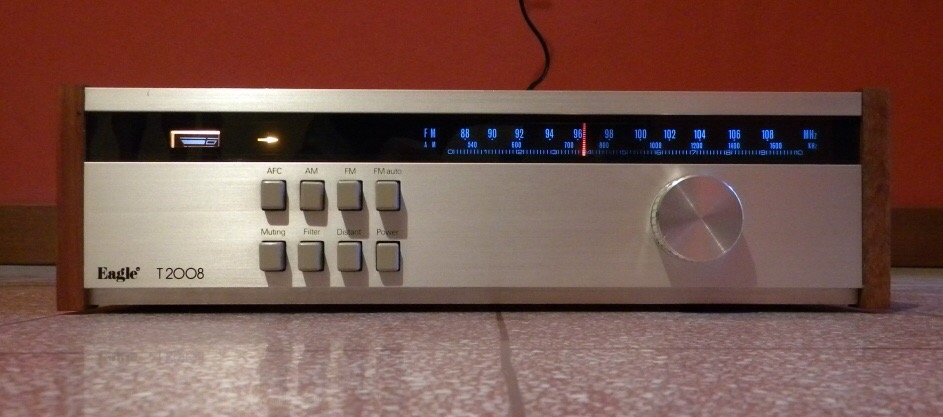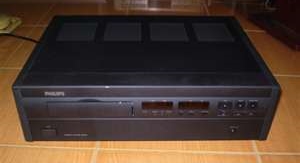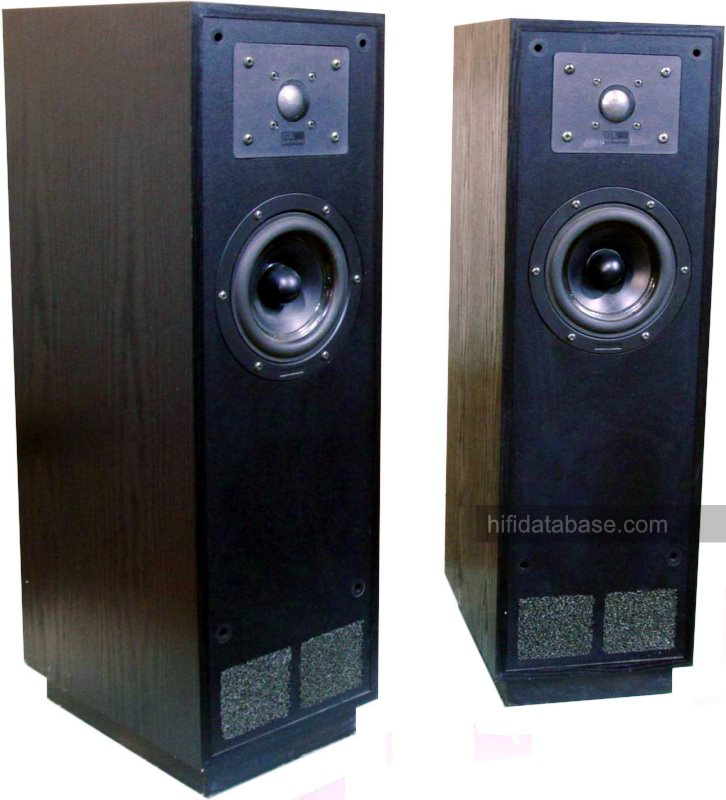I assembled my current system around the English loudspeakers TDL Studio 0.5 I bought in late 1991. The loudspeakers are the main responsible of a system’s sound, therefore they should be chosen first and should be paired to the right amplifier. I strongly believe a HiFi system should be able to reproduce the whole audible range correctly. At the same time, I’m aware most recordings lack much of the lower frequency range (under 40 Hz). Bookshelf loudspeakers, so fashionable for many years, just cannot reproduce the whole spectrum because of their limited size. The TDL loudspeakers use the “transmission line” technology to charge the low frequency drivers in order to obtain a low range of notable quality and extension in rather small boxes. The TDL Studio 0.5 can reproduce the audio range from 30 Hz on in an exceptional way. In doing so, in no way they affect the mid-high range as many bookshelf speakers fan would fear. Lower frequencies are seldom heard but felt – in your body, in your “guts”: a “full range” loudspeaker system has a different impact. You should start assembling a system from the loudspeakers, so I did – I had chosen mine. I found that the amplifier they would deserve was an Italian integrated: the Unison Research Mood that’s been playing the English speakers rather well from the end of 1991 to 2019, when I upgraded to the current Naim Nait 5i.
The beginnings
My passion for High Fidelity started when I was rather young, around 12 years of age. A cople of my uncles bought a stereo system from the Italian brand Augusta, an amplified turntable with two small speakers (at top). Thinking of it today, it was certainly not a well sounding system, but when I was at my uncles’ I never ceased listening to their records as I was fascinated by the stereo effect “producing different sounds from two speakers”. When they upgraded to a Technics coordinate system (not yet real HiFi but still working at my sister’s home), they gave the old Augusta turntable to me and suddenly I was the happiest teenager around. I could load several records at once, stacked one above the other. The Augusta would have put them down in sequence (so much for VTA!). It was fully automatic and could also play 78 RPM records. It had a double stylus: by flipping a small lever it turned to the other side and the 78 RPM stylus was exposed.
It also sported some DIN inputs. So, a few years later I added up a Technics M7 cassette deck, also still working at a friend of mine’s (at top). After a while, the same couple of uncles gave me an Eagle T2008 tuner. At their place, I had experienced my first radio listenings. I still remember it well, with its beautiful blue backlights, the small arrows that would light up when the station was tuned correctly, the elegant wooden lateral bars at its sides.
That was my first system. Hours and hours of uninterrupted listening, spoiled records, beautiful memories.
Then it was my parents’ turn to make gifts: they bought me a real separates system. Finally, I had a single module of a different brand for each purpose. Usually this is done by choosing the best affordable module for each task, a source, an amplifier and a pair of loudspeakers. In our case it was just about choosing the “most” affordable units you could find (no worries about pairing them). That’s it. After long hours of negotiations, we got out of the shop with a Mitsubishi DP-5 turntable (below), fully automatic, direct drive, strobo light speed control; if I remember well the cartridge was from AKG. But looking at it today, it still seems a good turntable. It may sell at almost 200e…
The integrated amp was actually cheaper: a humble Kenwood KA-30 (below)
that would have driven a pair of cheap speakers by Formula 80 (rather unknown manufacturer in Rome, Italy). I remember they had a safety system against misuse: a small red button popped out when they were forced beyond limits and they’d stop playing; by pushing it back in they would resume working. The cassette deck was still the Technics, that lived longer than the whole system. Again, there was a lot of music and beautiful youth memories. The quality was low, but it didn’t matter then. Good old times…
I took the system with me when my family moved back to Rome, where I was born and would soon start my university studies. There I had a couple of friends to discuss about High Fidelity, visiting shops for listening and dreaming about it. From those discussions I understood that maybe my system’s weaker point were the loudspeakers. I couldn’t afford new ones, so one of those friends of mine, a very good technician, convinced me to try the DIY way. Unfortunately, I took the inspiration from an ancient project by Genesis. My father built the wooden boxes which, although sturdy, were larger than deeper, as it was common in the 70s. The modern idea is making them as narrow as possible (I mean deeper than larger). Furthermore, I undertook a complicated 3-way crossover design using a dedicated software on a Commodore 64. The project included a large Ciare woofer in a closed box, a Pearless midrange and a Seas tweeter. The components were really good, except I had to live with a cheap Pioneer tweeter for budget reasons. But the crossover maintained the same design (and some mistake I wasn’t aware of) in the hope one day I could have afforded the Seas; so I never actually completed the project and I’ll never know how it would have sounded without those imperfections.
My second system
Then the CD players arrived! All around me the first units were appearing. Being on a budget as usual, I was the last among my friends to buy one. Like many at the time, I didn’t imagine the Compact Disc was not that miracle it was supposed to be. Like many, I had a cheap turntable placed on a desk to carry out its hard work of extracting music from the groove; I made no attempt whatsoever to adjusting it, fine-tuning it, setting it up. Like most people, I didn’t know anything about it. Therefore, the lacking of background noises when playing a CD captured me too. I happened to buy a cheap (again) Philips CD-16 player.
I was an avid reader of HiFi magazines and I tried to read between the lines to understand what products really distinguished themselves among the plethora of entry-level units sold at the time. It appeared that a new technology developed by Philips for the D/A conversion sections was able to deliver an amazingly good sound from low priced CD players. It was the “bitstream” technology of the so-called 1-bit converters. It really seemed their performance was good if compared to the price of the CD players fitted with those converters. I put my eyes on a JVC player someone believed to be a giant killer. It was the XL-Z431 (below), with Philips bitstream DAC for less than 200 thousand lire!
I also bought an Onkyo A-8200 integrated amp (below) critics were praising for its value at a price around 400 thousands, if I remember well. I found a buyer for the CD-16 but the Kenwood amp was unsellable. Finally I had a real HiFi source-amp pair! The quality advance was enormous, in spite of the naive DIY loudspeakers project and for many years I enjoyed it a lot.
Today
After my graduation in 1991, I collected a lot of tips from several happy relatives. I invested them in a MIDI keyboard that was flying off the shelves at the time: the Korg M1. I play guitar and I used to do jam sessions with friends in rented rehearsal places where we recorded demo tapes. Nothing special, really. I was planning to create MIDI bases on the computer to play them through the keyboard/sampler so I could play guitar along with a virtual band. I am no keyboard player, but I had some fun for a couple of months. After a promising job interview, I was planning to move to Milan. I figured that a new job wouldn’t have left me much time to work on MIDI bases, nor playing and programming. Maybe it would have been smarter to focus on a really good HiFi system, my real passion, by trying to upgrade the loudspeakers, the real weak point.
I started my search by browsing the usual magazines, too. I stumbled upon a rather enthusiastic review of a pair of transmission line loudspeakers from the English manufacturer TDL (Transducers Development Limited): the Studio 1, which had a shocking frequency response for their size. The whole audible range from 20 to 20000 hz was included and with an embarrassing quality in a less than 1 m tall box. Unbelievable! A thorough transmission line design was making this possible: a labyrinth inside the wooden box allows an ideal low frequency charge with no need for a very large box. The price was really good for that kind of project and the level of quality achieved, but by no means I could afford it. Like magic, a month later, in the same magazine, I found an even more enthusiastic review about the lesser TDL model, the Studio 0.5. They were even smaller (!), extending “only” down to 30 hz – almost a miracle. The price was still high, but this time I could make it. I had to listen to them! I went around Rome in search for HiFi stores. Finding the TDL was not easy. I could find the Studio 1 in a couple of stores but they immediately explained me how my small Onkyo amplifier was not in the same league non even as the Studio 0.5. They were not easy to drive, they would need an amplifier capable of high currents. They showed me fine English amps like the Mission Cyrus, the Naim Nait, and others form Audiolab, Musical Fidelity, Arcam. I sold the keyboard at he same price I’d bought it and finally I found a place where to listen to the Studio 0.5, by chance the same where I bought my CD Player and amp. Unfortunately, they didn’t have all those amps I had been advised to listen to. They hooked the TDLs to the only one from the list they had at disposal, a Musical Fidelity, if I remember well. I really liked what I heard. Yes, it should have been obvious since there was no comparison to the units they were supposed to replace at home. But the seller, good at his own job, told me such classy loudspeakers deserved even more.
They showed me an Italian amplifier I often saw in the HiFi shops I visited. Its shape was unmistakable, with its very elegant wooden chassis. It was the Unison Research Mood, which I had never considered since it was a bit out of my budget. Naturally, they made me listen to it, no obligations. The trick worked, since my father, who was with me, saw me smiling while listening to the set up and offered to pay for the difference. The TDLs really impressed me. I like a good, extended, not pumped-up and unrealistic low range. The Studio 0.5’s performance in that was astonishing. The key was the right amplifier. Miss the right combination and you’re in trouble. The whole system performance will be jeopardized. This is fundamental. The elegant Italian integrated amp drove the TDLs with comfort, never perturbed even during the most demanding tracks. Some workers of the sector later told me that the Mood was one of the few integrates capable of making the even bigger TDL Studio 1 really sing. I sold the small but honest Onkyo and since December 1991 my HiFi system has been centered around this British-Italian couple for many years until May 2019, when I bought a Naim Nait 5i, one of my greatest HiFi bargains ever.
As digital source many players alternated in my system. I had to upgrade my CD player almost immediately. At first I had to be satisfied with a Pioneer PD-8500 Reference, than the very good Cambridge Audio CD6. Later I renewed the digital source by buying a used Oppo 980H multiplayer. When it stopped working, I purchased a good Cambridge Audio D500SE; and the main source has become the old and gorgeous Thorens TD-160 turntable, as I’m back into vinyl since several years ago. However, as the bribing scandal known as “Tangentopoli” exploded in Italy, I lost my first job opportunity and I never moved to Milan. A long, sad period of unemployment was beginning, alternating to small jobs before i finally found my dream on – only to lose it in 2016.
Anyway, I still have a very good system going today, I’m very satisfied even if it has a certain age. The old turntable from the 70s aside (those decks do not suffer aging) amp and speakers were from late 1991! What ages with time are capacitors and coils, but it wouldn’t be expensive to have them replaced. Finally, I decided to sell the Mood and buy the nice Naim Nait 5i. The most delicate parts today are the subwoofer suspensions made of rubber that can often be corroded by humidity. They are easily replaced, too, no big deal. As of now, nothing really happened to my units. It is almost certain that modern technology would allow for a good system update. I’m sure the general sound quality would improve with newer components. I’ve upgraded the amplifier but unless I’ll have to cope with serious problems I don’t feel like replacing the loudspeakers from December 1991, unless unlikely occasions should arise.









